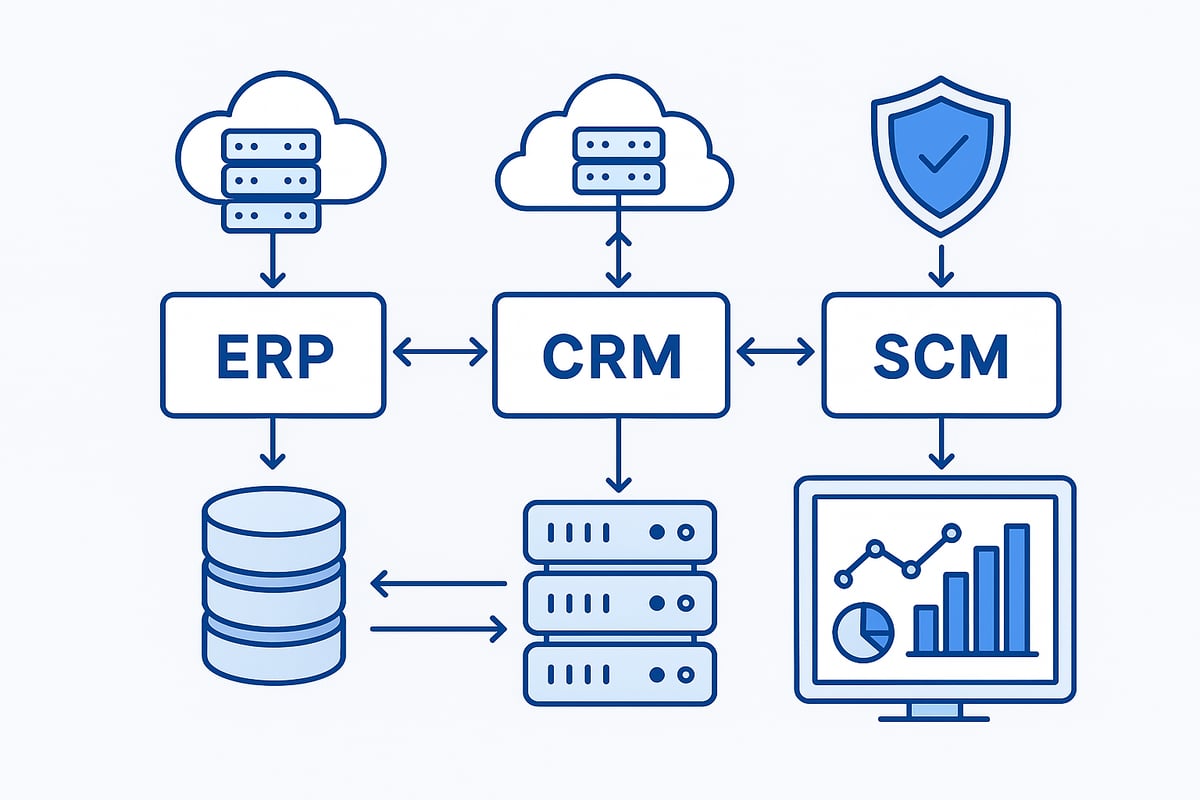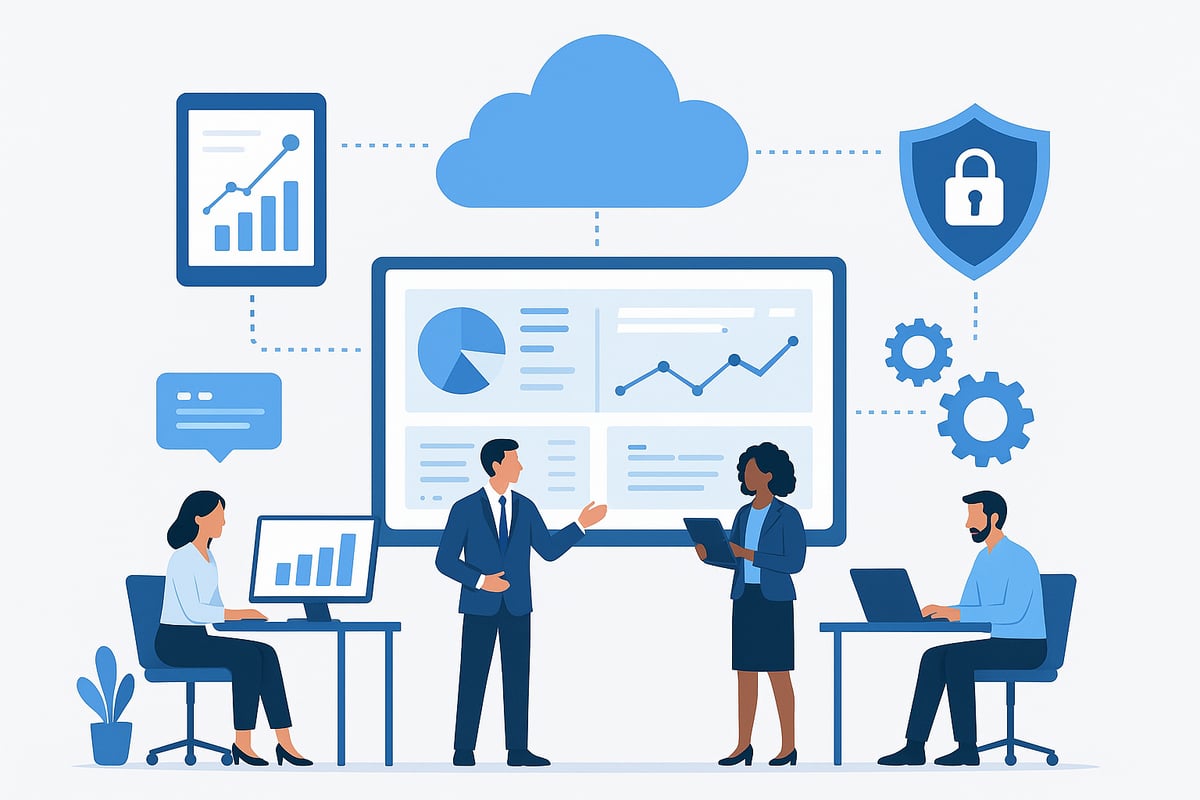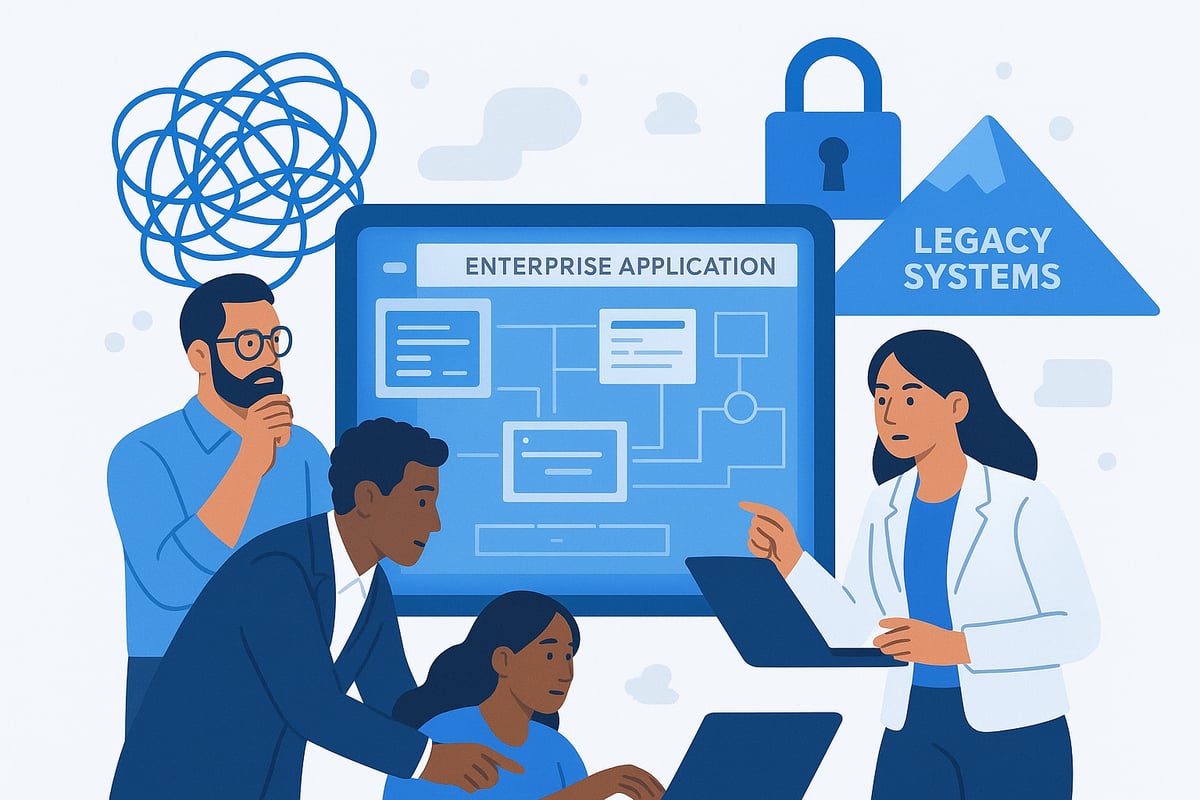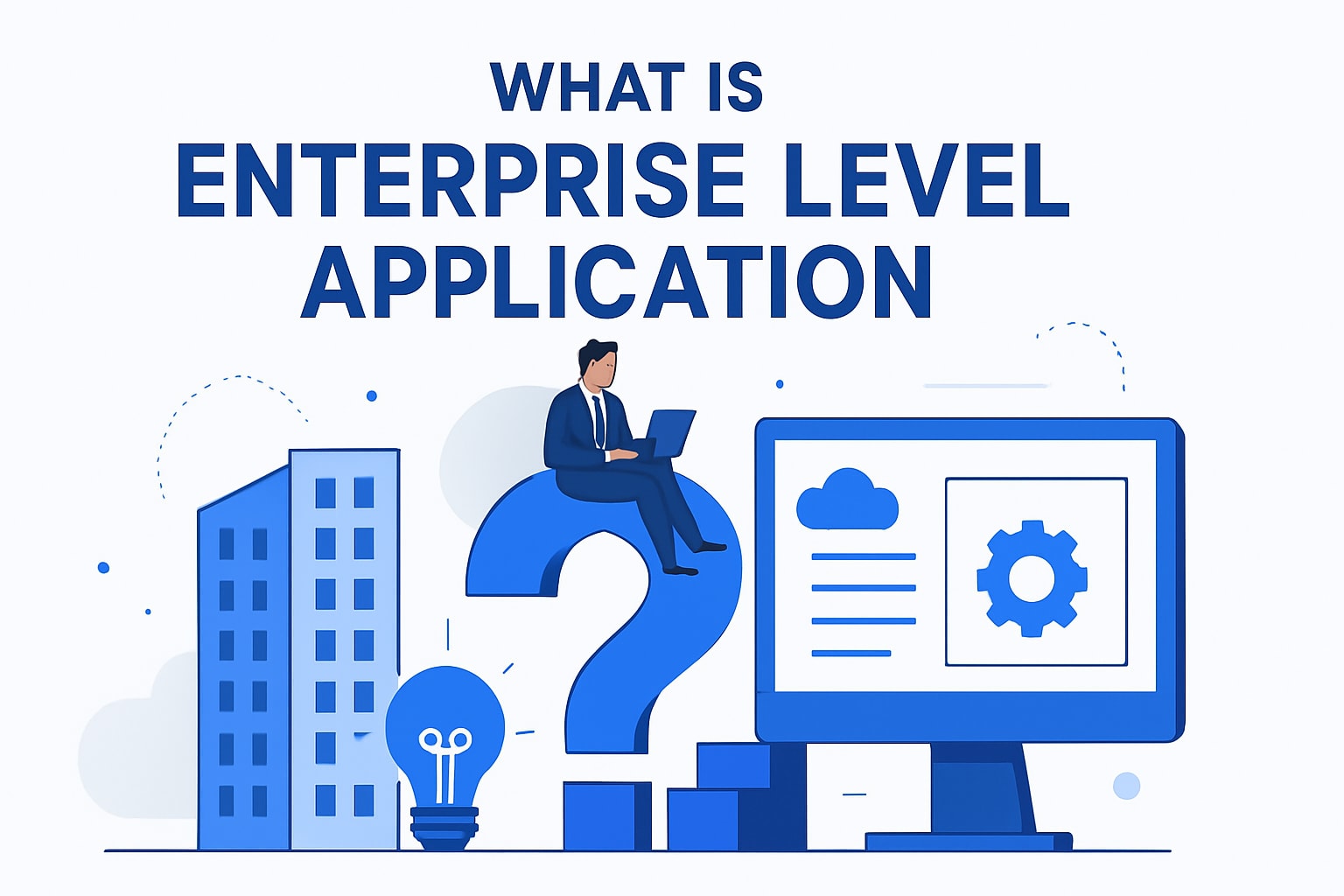In 2025, rapid digital transformation is reshaping how organizations operate, creating both challenges and opportunities for growth. Leaders everywhere are asking, what is enterprise level application, and how can it drive sustainable innovation?
This expert guide offers clear answers and practical insights. You’ll discover what defines enterprise applications, why they matter, and how they empower businesses to scale securely and efficiently. Explore essential characteristics, architecture, benefits, challenges, and future trends, all tailored to decision-makers ready to lead their companies forward.
Defining Enterprise Level Applications
In 2025, the question "what is enterprise level application" has become more relevant than ever as organizations seek robust digital solutions. An enterprise level application is a complex software system designed to support the entire operations of a large organization. These applications go beyond basic functionality, offering scalability, security, and integration capabilities essential for modern businesses.

What Is Enterprise Level Application in 2025?
To understand what is enterprise level application, consider its purpose: serving the complex, ever-evolving needs of large organizations. Unlike consumer apps or SMB solutions, these applications handle massive volumes of data, users, and transactions. They are built for mission-critical use, often supporting thousands of employees across multiple locations and time zones.
Enterprise applications must provide uninterrupted service, adapt to organizational growth, and comply with stringent regulatory standards. Their architecture is deliberately modular, making it possible to add, remove, or upgrade features with minimal disruption.
Comparing Enterprise, SMB, and Consumer Applications
A common question is how to distinguish what is enterprise level application from other types. Here’s a quick comparison:
| Feature | Enterprise Apps | SMB Apps | Consumer Apps |
|---|---|---|---|
| User Base | 1000s+ | 10s–100s | 1–10 |
| Scalability | High | Moderate | Low |
| Security | Advanced (compliance) | Standard | Basic |
| Integration | Extensive | Limited | Minimal |
| Customization | Deep | Moderate | Minimal |
| Examples | SAP, Salesforce | QuickBooks, Zoho | Instagram, Spotify |
This table highlights what is enterprise level application by showing its superior scalability, security, and integration compared to other categories.
Core Attributes of Enterprise Applications
Central to what is enterprise level application are core attributes that separate these tools from standard software:
- Scalability: Able to grow with business needs, supporting more users and transactions.
- Reliability: High availability and disaster recovery are built in.
- Security: Compliance with regulations like GDPR, HIPAA, and SOX.
- Integration: Connects seamlessly with other business systems and third-party tools.
For an in-depth look at these attributes, see Enterprise-Level Application Development.
Use Cases and Real-World Examples
When exploring what is enterprise level application, consider the broad range of use cases:
- ERP (Enterprise Resource Planning): Integrates finance, HR, procurement.
- CRM (Customer Relationship Management): Manages customer data, sales, and support.
- SCM (Supply Chain Management): Optimizes logistics and supplier networks.
- HRM (Human Resource Management): Handles payroll, recruitment, performance.
Real-world examples include SAP S/4HANA for enterprise resource planning, Salesforce for CRM, Oracle Cloud for business intelligence, and Microsoft Dynamics 365 for unified business operations. These platforms are trusted by Fortune 500 companies to drive efficiency and innovation.
Market Growth and Compliance
The enterprise software market is booming. According to Statista, global spending on enterprise applications is projected to exceed $650 billion in 2025. This surge is fueled by the need for advanced digital tools and compliance with ever-tightening regulations.
Meeting requirements like GDPR, HIPAA, and SOX is non-negotiable for enterprise software. This is a defining factor in what is enterprise level application, as non-compliance can lead to significant legal and financial risks.
Role in Digital Transformation and Business Agility
Understanding what is enterprise level application is crucial for digital transformation. These applications empower organizations to adapt quickly to market changes, automate processes, and gain real-time insights from centralized data.
Enterprise applications are the backbone of business agility. They enable companies to innovate, scale, and remain competitive in a rapidly changing landscape.
Core Architecture and Technologies of Enterprise Applications
Modern organizations often ask: what is enterprise level application architecture, and why does it matter so much in 2025? The answer lies in how these applications are designed to handle immense complexity, massive user bases, and ever-changing business requirements.
A robust architecture is the foundation that allows enterprise applications to scale, integrate, and remain secure. Let’s break down the essential components and technologies that define the backbone of these mission-critical systems.

Key Architectural Principles
When considering what is enterprise level application design, several architectural principles stand out as essential. First, modularity is key—breaking down the application into loosely coupled, independently deployable modules makes scaling and updating much easier.
Service-oriented architecture (SOA) and microservices take this further by enabling each component to communicate via APIs. This ensures high availability, as failures in one service do not bring down the whole system.
Other critical principles include:
- Multi-tenancy for serving multiple clients on shared infrastructure.
- Horizontal scalability, allowing the application to handle increased loads by adding more resources.
- Data integrity and strong consistency models, which protect sensitive business information.
- An API-first approach, ensuring seamless interoperability between internal and external systems.
These principles are central to answering what is enterprise level application development in 2025. They ensure reliability, flexibility, and a future-proof foundation for innovation.
Foundational Technologies
The technologies underpinning what is enterprise level application architecture continue to evolve rapidly. Cloud-native infrastructure is now standard, with AWS, Azure, and Google Cloud offering elastic resources and global reach.
Databases play a pivotal role:
| Database Type | Examples | Best For |
|---|---|---|
| Relational | PostgreSQL, Oracle | Structured data, transactions |
| NoSQL | MongoDB, Cassandra | Unstructured, scalable workloads |
DevOps and CI/CD pipelines allow for rapid deployment and continuous improvement, while robust security frameworks (OAuth, SSO, IAM) protect data and users.
AI and automation are now embedded at every layer, from intelligent data processing to predictive analytics. This fusion of foundational tech ensures that what is enterprise level application capability goes beyond traditional software, delivering smarter, more adaptive solutions.
Integration and Interoperability
One of the toughest questions in enterprise IT is: what is enterprise level application integration, and why is it so complex? The answer lies in the sheer diversity of systems that must work together—legacy databases, third-party APIs, IoT devices, and more.
Middleware and enterprise service buses (ESB) enable different applications to communicate reliably. RESTful APIs, GraphQL, and event-driven architectures provide flexible, scalable ways to connect services.
For example, a simple REST API endpoint for user data might look like:
GET /api/v1/users/{user_id}
Authorization: Bearer <token>
Integration also involves:
- Third-party connections (payment gateways, analytics tools)
- Data synchronization and master data management
- Real-time processing and actionable analytics
For organizations seeking a deeper dive into integration strategies, the Developing Enterprise Applications Guide offers practical advice and proven approaches.
Ultimately, mastering what is enterprise level application integration is crucial for enabling business agility, innovation, and a unified digital ecosystem.
Key Benefits of Enterprise Level Applications
Enterprise leaders often ask, what is enterprise level application and why should it matter to their organization? The answer lies in the significant, tangible benefits these robust solutions deliver. In 2025, enterprise applications are not just about keeping up—they are about gaining a competitive edge.

Enhanced Efficiency and Productivity
One of the most compelling answers to what is enterprise level application is its unmatched ability to drive operational efficiency. These platforms automate repetitive tasks, streamline workflows, and reduce manual errors. As a result, employees spend less time troubleshooting and more time focusing on strategic initiatives.
For example, a global retail chain using SAP for unified inventory and sales management saw a dramatic reduction in stockouts and excess inventory. This translated to faster response times and improved customer satisfaction.
Centralized Data and Better Decision-Making
Enterprise applications centralize data, breaking down silos and providing a single source of truth. Decision-makers benefit from real-time analytics, which empower them to act on insights quickly and accurately.
A financial institution, for instance, used integrated enterprise software to streamline compliance and reporting. This not only simplified regulatory processes but also enhanced the speed and accuracy of business decisions.
Scalability and Global Reach
Another advantage tied to what is enterprise level application is scalability. As companies grow or expand into new regions, enterprise applications support increased transaction volumes and new users without a hitch. Their modular architecture makes it easy to add new features or integrate with additional systems.
According to Gartner, 80% of enterprises reported notable productivity gains after modernizing their application stack in 2024. This scalability enables businesses to pursue global opportunities with confidence.
Security, Compliance, and Risk Mitigation
Robust security and compliance are non-negotiable for enterprise applications. They offer advanced access controls, encryption, and audit trails to help organizations meet regulations like GDPR, HIPAA, and SOX. This is crucial for protecting sensitive data and building trust with customers and partners.
By ensuring data privacy at scale, these solutions minimize risk and safeguard the business from costly breaches or compliance failures.
Cost Savings, Automation, and Customer Experience
Modern enterprise applications deliver substantial cost savings through process automation and optimization. By reducing manual workloads, companies can allocate resources more efficiently and cut operational costs.
Customers also benefit. Enhanced digital experiences, personalized interactions, and faster service all result from the capabilities of enterprise platforms. For a deeper dive into the business value and benefits of these solutions, see the Enterprise App Development Services Overview.
| Benefit | Impact Example |
|---|---|
| Efficiency | SAP for inventory automation |
| Decision-Making | Financial institution compliance reporting |
| Scalability | Global operations and transaction support |
| Security & Compliance | GDPR, HIPAA, SOX alignment |
| Cost Savings | Process automation and reduced overhead |
The Bottom Line: Sustainable Growth and Agility
Ultimately, what is enterprise level application if not a catalyst for sustainable business growth and agility? These solutions empower organizations to move faster, adapt to market changes, and deliver superior value to customers. By investing in modern enterprise applications, companies position themselves for long-term success in an ever-evolving digital landscape.
Challenges in Developing and Implementing Enterprise Applications
Building and deploying enterprise-level solutions is never a straightforward journey. Organizations must navigate a complex web of technical, operational, and human challenges. Understanding what is enterprise level application is crucial because these hurdles can make or break digital transformation initiatives.

Complexity and Stakeholder Alignment
One of the first obstacles is deciphering the full scope of what is enterprise level application for your organization. Requirements gathering involves input from multiple departments, each with unique goals and pain points.
Stakeholder alignment can be tough, especially in large organizations. Miscommunication or unclear objectives often lead to delays and missed expectations. To avoid this, decision-makers should facilitate open workshops and collaborative planning sessions.
Budget Overruns and Project Management
Budgeting for enterprise applications is notoriously difficult. According to the Standish Group, 31% of IT projects fail to meet their objectives, often due to unforeseen costs or shifting requirements.
Project management pitfalls include scope creep, resource misallocation, and lack of clear milestones. Adopting agile methodologies and phased rollouts can help teams stay on track. For a deeper dive on these issues, see Enterprise Application Development Challenges.
Integration with Legacy Systems
A major challenge in defining what is enterprise level application is integrating new platforms with existing systems. Many enterprises rely on legacy infrastructure that was never designed for modern interoperability.
Data migration can be risky. Inaccurate transfers or inconsistent data models may cause operational disruptions. Teams should invest in robust middleware and thorough validation processes to ensure a smooth transition.
Security and Data Privacy at Scale
Security must be built into every layer. As enterprises scale, the risk of breaches and data leaks grows. Handling sensitive data in compliance with regulations like GDPR, HIPAA, or SOX adds another layer of complexity.
Balancing accessibility with protection is a constant struggle. Security frameworks, regular audits, and proactive monitoring are essential for any organization asking what is enterprise level application and aiming for trust and compliance.
Change Management and Performance Optimization
Rolling out a new enterprise application affects everyone, from executives to end-users. Resistance to change is common, especially if new workflows disrupt established habits.
User adoption requires clear training, ongoing support, and transparent communication. Performance optimization is also critical. High transaction volumes or global operations demand scalable infrastructure and continuous tuning.
A healthcare provider integrating electronic health records (EHR) systems, for example, often faces slow adoption rates and technical glitches. Agile feedback loops and incremental updates can ease the transition.
Step-by-Step Guide to Building a Modern Enterprise Application in 2025
Building a modern solution starts with a clear understanding of what is enterprise level application and how its complexity shapes the development process. In 2025, success depends on a methodical, collaborative approach. Here is a step-by-step guide to ensure your enterprise project delivers lasting value.
Step 1: Requirement Analysis and Stakeholder Alignment
Every journey into what is enterprise level application begins with requirements. Identify your business objectives and key performance indicators.
Gather input from cross-functional teams—IT, operations, compliance, and end-users. This ensures priorities and pain points are captured early.
Document all compliance and security needs, especially if your sector is regulated. Early alignment reduces surprises and sets the stage for a smooth project.
Step 2: Choosing the Right Architecture and Technology Stack
Choosing the right foundation is essential when considering what is enterprise level application. Decide between cloud, on-premises, or hybrid deployment models based on your organization’s needs.
Evaluate frameworks, programming languages, and platforms that support scalability, security, and integration. Factor in future growth and interoperability with existing systems.
Assess whether low-code or no-code platforms are appropriate for rapid prototyping or specific business processes. The right stack empowers your team and future-proofs your solution.
Step 3: Design and Prototyping
User experience is at the heart of what is enterprise level application. Apply user-centric UI and UX principles to create intuitive, accessible interfaces.
Develop wireframes and interactive prototypes to visualize workflows and collect feedback. Involve end-users early to validate assumptions and refine requirements.
Rapid prototyping reduces costly changes later and ensures alignment with business goals. Use collaborative tools to streamline this phase.
Step 4: Agile Development and Testing
Adopting agile practices streamlines what is enterprise level application development. Organize work into sprints, delivering functional increments for review and adjustment.
Automate testing at every stage: unit, integration, and security. Continuous integration and deployment pipelines help catch issues early and enable rapid delivery.
Regular sprint reviews keep stakeholders engaged and ensure the product evolves with business needs.
Step 5: Integration and Data Migration
Seamless integration is a hallmark of what is enterprise level application. Connect new systems with existing databases, APIs, and third-party tools.
Plan data migration carefully, mapping legacy data to the new environment. Validate data integrity and accuracy throughout the process.
Test integrations with real-world scenarios to avoid disruptions post-launch.
Step 6: Deployment, Monitoring, and Optimization
The final step in delivering what is enterprise level application is a controlled deployment. Use staged strategies like canary or blue/green releases to minimize risk.
Set up real-time monitoring and analytics for performance and security. Collect user feedback and usage data to guide ongoing optimization.
Continuous support and tuning ensure your application remains robust, secure, and aligned with business goals.
Future Trends and Innovations in Enterprise Applications
The pace of change in enterprise technology is accelerating, making it essential to ask what is enterprise level application in the context of tomorrow's innovations. By 2025, organizations must stay ahead of trends that are reshaping how they build, deploy, and leverage enterprise solutions.
AI-Driven Automation and Decision Intelligence
Artificial intelligence is quickly becoming the backbone of what is enterprise level application. By 2025, IDC predicts 65% of enterprise apps will leverage AI or machine learning for automation and smarter decision-making.
AI-driven automation streamlines workflows, enhances accuracy, and uncovers actionable insights in real time. Decision intelligence platforms help leaders make data-backed choices, improving agility and competitiveness. Enterprises are using AI for predictive maintenance, fraud detection, and personalized customer experiences.
For those interested in the technical evolution, the adaptation of enterprise API architectures to support AI agentic workflows is explored in AI in Enterprise APIs.
Low-Code and No-Code Platforms Democratize Development
A major shift is underway as low-code and no-code platforms empower non-developers to build robust enterprise solutions. This democratization of development is changing what is enterprise level application by speeding up prototyping and reducing costs.
Business teams can now automate workflows, create internal tools, and launch MVPs in weeks rather than months. According to recent low-code platform adoption statistics, enterprises are rapidly moving away from legacy solutions in favor of flexible, visual platforms.
This trend allows companies to innovate faster, adapt to market changes, and reduce IT bottlenecks.
Cybersecurity and Zero-Trust Architectures
As enterprise applications become more interconnected, cybersecurity is a top concern. Zero-trust architectures are redefining what is enterprise level application by requiring continuous authentication and strict access controls.
Modern solutions integrate advanced threat detection, encryption, and identity management. This approach minimizes risk, especially as remote work and cloud adoption grow. Enterprises are also focusing on compliance with regulations such as GDPR and HIPAA.
Edge Computing and IoT Integration
Edge computing is transforming enterprise applications by processing data closer to its source. This trend is crucial for industries relying on IoT devices, where real-time analytics drive efficiency.
For example, manufacturing firms use IoT sensors connected to AI platforms for predictive maintenance, reducing downtime and optimizing operations. Edge computing also supports low-latency applications, improving responsiveness for critical business functions.
Hyper-Personalization and Big Data Analytics
Big data continues to be a game changer for what is enterprise level application. Enterprises are harnessing massive datasets to deliver hyper-personalized experiences, from tailored marketing to individualized service recommendations.
Advanced analytics tools help organizations uncover patterns, forecast trends, and make smarter decisions. As data volumes grow, scalable analytics platforms are essential for maintaining a competitive edge.
Sustainability and Green IT in Enterprise Solutions
Sustainability is now a core consideration in enterprise technology. Organizations are seeking greener IT solutions, optimizing resource usage, and reducing carbon footprints.
Cloud providers are investing in renewable energy, and software vendors are designing applications for energy efficiency. As environmental regulations tighten, sustainable practices will define the next generation of enterprise applications.
Looking Ahead
The future of what is enterprise level application is shaped by rapid innovation, user empowerment, and a relentless focus on security and sustainability. By embracing these trends, organizations can unlock new value, stay resilient, and lead in the digital era.
No-Code and AI: Transforming Enterprise Application Development
No-code and AI are redefining what is enterprise level application in 2025. Enterprises now build robust apps faster, empowering teams to innovate without deep coding expertise. This shift accelerates digital transformation, making complex solutions accessible to more organizations.
Speed, Cost-Efficiency, and Accessibility
The biggest change in what is enterprise level application comes from no-code’s speed and AI’s intelligence. Teams can now launch prototypes, automate workflows, and create internal tools in days, not months. This democratizes app development, reducing both costs and technical barriers.
According to Why No-Code Development Is the Future of Software for Enterprises, organizations benefit from rapid iteration and flexibility. No-code platforms allow business users to experiment, while AI handles complex data or automation.
Comparison Table: Traditional vs. No-Code/AI
| Approach | Development Speed | Required Skills | Cost |
|---|---|---|---|
| Traditional | Months | Developers | High |
| No-Code + AI | Days to weeks | Business users | Lower |
Real-World Impact and Specialist Agencies
Enterprises are now delivering MVPs and workflow automations in record time. Agencies specializing in no-code and AI, such as Big House Technologies, offer end-to-end services for scoping, design, and deployment. Their expertise ensures enterprise apps are scalable, secure, and future-proof.
This evolution makes enterprise-level innovation more accessible than ever before, positioning organizations for rapid growth and agility.
Now that you’ve got a clear picture of what enterprise level applications are and what it takes to build one in 2025, you might be wondering how to turn these insights into action for your own business. Whether you’re an enterprise leader or a founder with a big idea, speed and flexibility matter more than ever. Imagine launching your MVP in weeks—not months—while ensuring it’s scalable, secure, and ready for real growth. If you’re ready to move fast and see how no code can bring your vision to life, check out how you can Launch Your MVP in Weeks, Not Months.




About Big House
Big House is committed to 1) developing robust internal tools for enterprises, and 2) crafting minimum viable products (MVPs) that help startups and entrepreneurs bring their visions to life.
If you'd like to explore how we can build technology for you, get in touch. We'd be excited to discuss what you have in mind.
Other Articles
Discover the 2025 software house guide—learn definitions, services, trends, and how to choose the right partner for digital transformation and project success.
Explore the latest website development technologies for 2025. Discover top tools, frameworks, and trends to build scalable, secure, and future-ready websites.
Explore the 7 best Replit alternative platforms for 2025 Compare features pricing and benefits to find the ideal cloud IDE for your coding and team needs

